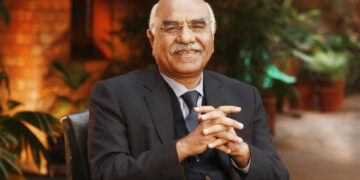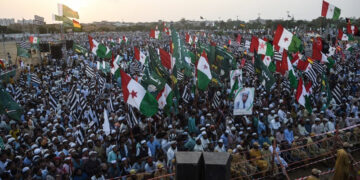 We have reached the end of the year. This has been a difficult year for Pakistan because of its political, economic, societal and security problems against the backdrop of a troubled regional environment.The biggest achievement of the year is that the doomsday scenarios predicted for Pakistan by many in Pakistan and outside did not materialise. These scenarios were not based on a dispassionate study of the international, regional and national situation. Rather, most Pakistani advocates of these doomsday scenarios examined the situation from a narrow and paranoid state of mind that described any situation as hopeless if it did not fit into their notions of the ideal.Pakistan can be described as a troubled state whose political, economic and security problems can be addressed. However, neither will a saviour come from the Heavens nor will Pakistani leaders become a replica of the notion of the ideal rulers derived from the earliest period of Islamic history. The solution to the problems lies in raising the right questions to improve political and socio-economic problems, making use of the experience of other societies and avoiding clichés that do not respond to the challenges of the 21st century.
We have reached the end of the year. This has been a difficult year for Pakistan because of its political, economic, societal and security problems against the backdrop of a troubled regional environment.The biggest achievement of the year is that the doomsday scenarios predicted for Pakistan by many in Pakistan and outside did not materialise. These scenarios were not based on a dispassionate study of the international, regional and national situation. Rather, most Pakistani advocates of these doomsday scenarios examined the situation from a narrow and paranoid state of mind that described any situation as hopeless if it did not fit into their notions of the ideal.Pakistan can be described as a troubled state whose political, economic and security problems can be addressed. However, neither will a saviour come from the Heavens nor will Pakistani leaders become a replica of the notion of the ideal rulers derived from the earliest period of Islamic history. The solution to the problems lies in raising the right questions to improve political and socio-economic problems, making use of the experience of other societies and avoiding clichés that do not respond to the challenges of the 21st century.
The PPP-led federal government, and especially President Asif Ali Zardari, were under pressure by the superior judiciary and political adversaries. The Supreme Court (SC) judgment on the National Reconciliation Ordinance on December 16, 2009 reopened the cases against over 2,000 people, which included 34 political leaders, including 10-12 leaders from the PPP. However, the whole focus of the opposition was on the PPP leaders and especially on President Zardari. The SC and the opposition leaders insisted on the reopening of corruption cases against Zardari while ignoring the constitutional immunity from criminal prosecution afforded to the president. An appeal is also pending against the president in the Lahore High Court (LHC) for disallowing the president to hold party office. Though the constitutional provision debars the president from holding an office-of-profit only, the LHC is pursuing the case while the lawyers from the president’s side have withdrawn in protest at what they describe as not getting the proper attention of the court to their pleas.
The superior courts have to deal with more political cases now than in the past. Most of these matters should be settled in the political domain or by parliament. The principal reason for the filing of political appeals is the widely shared perception in political circles that the relations between the PPP and the superior judiciary are strained. Therefore, the PPP adversaries are hoping that the superior judiciary may reprimand or embarrass the PPP government, which they think could lead to a clash between the executive and the judiciary, further undermining the working of the present political order. This also creates an opportunity for the opposition to demand the resignation of the PPP government, its president, or both.However, this self-cultivated hope of the PPP adversaries did not materialise and the superior courts and federal government maintained working relations. The SC’s decision to approach parliament for some changes in the procedure for the appointment of judges was a good gesture, which parliament honoured by passing the 19th constitutional amendment this month.The most notable accomplishment was the unanimous approval of the 18th constitutional amendment by parliament to remove most of the distortions made in the 1973 constitution by General Ziaul Haq and General Pervez Musharraf. Prior to this, an all-party constitutional amendment committee deliberated for several months to prepare the draft bill for the amendment.
The federal and provincial governments were unable to ensure governance to the satisfaction of the people. There were serious complaints of mismanagement, negligence and partisan use of official discretion and state patronage. The complaints of corruption and money making surfaced in the media against all governments, especially against the federal government.The economy continued to be a major threat to Pakistan’s stability. Pakistan relies heavily on external financial assistance and remittances from overseas Pakistanis. The IMF restructuring programme, worth over $ 11 billion, was to conclude by the end of December. The Pakistan government has requested for an extension because it has failed to convince parliament to pass the Reformed General Sales Tax (RGST) this month as a condition for receiving the last instalment of the restructuring fund. This delay has embarrassed the government at the international level. In mid-December, Pakistan’s external debt amounted to $ 53.7 billion.The economy received an additional setback as the floods devastated all the four provinces and Gilgit-Baltistan in August-September, affecting 20.2 million people. Other losses included 1.9 million houses damaged and destroyed, 1.2 million livestock lost (excluding poultry), 10,865 schools damaged or destroyed and 1,961 reported deaths.
Ordinary people were hit hard by the price hikes of all food items and essential commodities for household use. It seemed that the federal and provincial governments were unable or unwilling to manage the price hike. This was coupled with acute shortages of sugar, wheat flour and cooking oil on different occasions in the year. Such shortages were manipulated by big businesses, traders and industrialists, enabling them to make a lot of money. This increased poverty and despondency in Pakistan.The inability of the government to salvage the economy and ease economic pressures on the people discredited the PPP government more than anything else. It launched the Benazir Income Support Fund and adopted some other measures to help the poor but poverty and underdevelopment could not be controlled.Periodic confrontation between the PPP and the PML-N, especially in Punjab, often revived the memories of their bitter conflict during 1988 to1999. In Sindh, a triangular conflict involving the MQM, the ANP and the PPP created the spectre of instability. Target killings in Karachi threatened peace, stability and the economy of Karachi, with negative implications for the rest of the country.Balochistan’s political scene was marred by killings, including of people from other provinces by various separatist groups. This was accompanied by sectarian killings. Religious extremism and terrorist attacks, including suicide bombings, were witnessed in various cities, especially in and around Peshawar.Pakistan’s security forces were fully engaged in counter-terrorism and counter-insurgency operations in the tribal areas. Though they took control of many areas, the Pakistani Taliban and other militants continued to pose a formidable challenge. Terrorism and religious extremism threatened Pakistan more than external security pressures – Dailytimes – Dr Hasan Askari Rizvi










